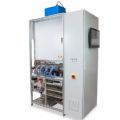- Home >
- Organizations >
- HZB

Helmholtz-Zentrum Berlin Bessy II Experimental hall
HZB at a glance
Helmholtz-Zentrum Berlin für Materialien und Energie GmbH (HZB) is a legally independent member of the Helmholtz Association of German Research Centres, financed by the Federal Government (90%) and the State of Berlin (10%), and has an annual budget of approx. 150 million € with ca. 1,100 employees. HZB also operates BESSY II, which is a third-generation synchrotron radiation source that produces extremely bright X-ray light, and offers access and user support to ca. 3,000 user visits per year.
The mission of HZB focuses on materials research for a sustainable, economic and secure energy supply in the future. The approach includes the understanding of:
- basic principles,
- the development of dedicated infrastructures that allow guided design, synthesis and, analysis,
- the transfer to applications providing know-why and know-how for the society.
HZB’s energy materials research focuses on materials for energy conversion (solar cells) and storage (solar fuels, electrochemical storage), as well as quantum materials (spintronics) that could be of relevance in novel, energy-efficient information technologies. Catalysis materials are also being developed at HZB, for example for artificial photosynthesis and processes for CO2 conversion. Research on energy materials is closely connected with the operation and development of the BESSY II photon source and dedicated unique infrastructures like EMIL, HySPRINT, or the Berlin Joint EPR Lab. The research and development approach focus on thin-film technologies. HZB’s Competence Centre Photovoltaics Berlin (PVcomB) together with HySprint core lab develop photovoltaic technologies and products jointly with industry. It has made significant contributions to the field of photovoltaic module technologies and related production processes and has now extended its contribution to neighboring fields such as Building Integrated Photovoltaics.
Role in the project
- Project coordination: HZB provides the administrative and scientific coordination of the project ensuring that the objectives and milestones of the project are efficiently and effectively met, on time and within budget. Additionally, HZB will promote efficient communication flows within the consortium guaranteeing that each partner is well informed of the project progress, understands its role and contractual obligations in the project, and is aware of the requests and information from the European Commission.
- HZB will lead the management of the proposals through the single access point platform (GATE) and provide access to VIPERLAB’s research infrastructures. HZB will publish the calls, support the users with their submission of proposals for transnational and virtual access, elaborate the standardized routine of evaluation for user’s proposal, support the evaluation process with the external experts and guide and support the successful implementation of the granted proposal.
- HZB will also enable access to its Perovskite Database and contribute to the development of guidelines for virtual access through the VAPo (Virtual Access Point).
- HZB will actively support the Joint Research Activities in VIPERLAB: Leading the task “Literature data mining for meta-studies on perovskite single- and multi-junction devices” HZB will launch the perovskite database and will correlate device architectures, material properties, and fabrication protocols to device properties and summarise this information in meta studies. Leading the task “Advanced spectroscopic characterization of device degradation” HZB and other partners will develop protocols for testing procedures. Additionally, HZB will contribute to other joint research activities with its expertise in aging protocols and encapsulation methods and supporting the assessment of the environmental and social impact.
- HZB will manage and support the implementation of ethics requirement in the VIPERLAB project.
Links
Infrastructures
- X-ray photoemission with excitation from 80 eV 10 keV photons
- X-ray absorption in the soft and “tender” x-ray range
- In-system sample treatments (e.g., heating, thin-film evaporation
- A mySQL-based database promoting OpenScience practices in the perovskite PV research community
- Enabling literature research and dissemination/sharing of scientific data according to FAIR data principles
Expertise
VIPERLAB Main contact


VIPERLAB Key persons




VIPERLAB associated Experts/Scientists

Webinars
[1] - Took place on Feb, 08th 2022
Modelling, high performance computing and efficient access to data sets based on data reported in the literature and experimental work are important tools to accelerate research in the field of photovoltaic perovskite, and beyond. With this workshop VIPERLAB presents the importance of these topics for materials science technology and how the 4 virtual infrastructures of Viperlab project can support researchers from academy'and industry, with free access to their computing, modeling tools and the available datasets.
[1] - Took place on Nov, 30th 2022
H2020 VIPERLAB Project offers free access to the state-of-the-art perovskite EU infrastructures that cover the whole innovation/value chain from material preparation to characterization of perovskite devices and modules. Today we present two very relevant VIPRLAB research Infastructures: FRAUNHOFER Solar Cell Manufacturing & Characterization & EPFL/CSEM – PV lab/PV Center & PSK/SI Tandem processing.
[1] - Took place on Dec, 15th 2022
We present other two VIPERLAB Research Infrastructures. The first, CHOSE consists of two main infrastructures: the CHOSE@ROME, is located on the campus of the University of Rome Tor Vergata (Italy), and focuses on technological manufacturing processes and device characterization. CHOSE@TURIN, is an infrastructure associated with the University of Turin (Italy) focused on the development of materials. The secon, AIT Viperlab Reseach infrastructures focusses on characterization and reliability tools for the accreditation tests of PV modules, and tools for PV deposition, characterization/reliability and development of thin film coatings.
[1] - Took place on Jan, 26th 2023
The stability of perovskite devices is a key point should be addressed to achieve commercialisation. The key factors influencing the stability of the devices are the exposure to oxygen and moisture, UV light, solution processing and thermal effects. Encapsulation and standard testing protocols are required to check and improve stability. The two presented infrastructures offer state of the art equipment for the Perovskite Stability testing of materials and devices.
[1] - Took place on Jan, 17th 2024
The “VIPERLAB Webinar on Standardization for Perovskite PV” is a half-day online event on standardization activities in the field of PV, focusing on Perovskite materials and devices. Experts from international research institutes report on the current activities of the IEC Technical Committees 113 and 82, ISOS and PSK-ISOS, as well as on standardization activities regarding data ontologies and RDM.
Publications
Natalia Maticiuc, Eva Unger, Rutger Schlatmann
Francesco Roca, David Casaburi, Antonella De Maria, Massimo Izzi, Vera La Ferrara, Manuela Ferrara, Paola Delli Veneri, Eva Unger, Natalia Maticiuc, Stephan Abermann, Raquel Alemañ, Aldo Di Carlo, Theodoros Dimopoulos, Jens Hauch, Mykhailo Sytnyk, Narges Yaghooni Nia
Eva Unger, Jesper Jacobsson
Mark Khenkin; Hans Köbler; Marko Remec; Rajarshi Roy; Ulas Erdil; Jinzhao Li; Nga Phung; Ghefar Adwan; Gopinath Paramasivam; Quiterie Emery; Eva Unger; Rutger Schlatmann; Carolin Ulbrich; Antonio Abate
Suchan, Klara; Jacobsson, T. Jesper; Rehermann, Carolin; Unger, Eva L.; Kirchartz, Thomas; Wolff, Christian M.
Paolo Graniero; Mark Khenkin; Hans Köbler; Noor Titan Putri Hartono; Rutger Schlatmann; Antonio Abate; Eva Unger; T. Jesper Jacobsson; Carolin Ulbrich
Noor Titan Putri Hartono; Hans Köbler; Paolo Graniero; Mark Khenkin; Rutger Schlatmann; Carolin Ulbrich; Antonio Abate
Hans Köbler, Sebastian Neubert, Marko Jankovec, Boštjan Glažar, Martin Haase, Clemens Hilbert, Marko Topic, Bernd Rech, Antonio Abate
Feray Ünlü, Alejandra Florez, Keely Dodd-Clements, Carolin Rehermann, Matthias Grosch, Florian Mathies, Sanjay Sanjay, Eva Unger












